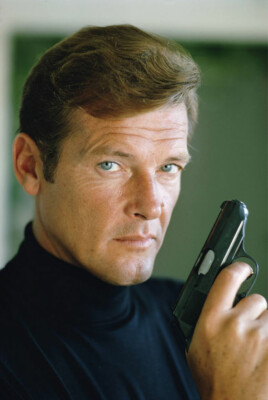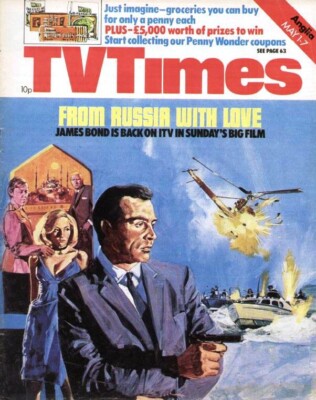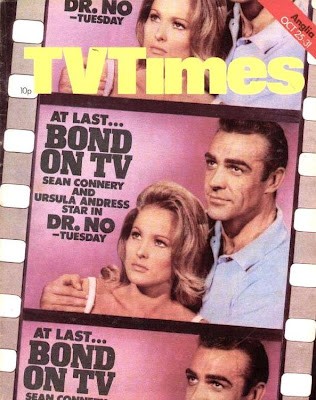 Bond has been Back on the Box in March. With the UK’s TV channels ITV4 and ITVX currently engaged in a special Bond film season (the latest being Skyfall, screened on Friday 15th March, followed by an ‘edited for violence’ version of Dr. No on Saturday 16th March), it seems a good opportunity for the JBIFC to take a look back on the heyday of 007 on British television, and recall a time when Bond on TV was treated as something really special, an ‘event’ that would help celebrate a Bank Holiday or seem as ‘traditional’ as Christmas Day.
Bond has been Back on the Box in March. With the UK’s TV channels ITV4 and ITVX currently engaged in a special Bond film season (the latest being Skyfall, screened on Friday 15th March, followed by an ‘edited for violence’ version of Dr. No on Saturday 16th March), it seems a good opportunity for the JBIFC to take a look back on the heyday of 007 on British television, and recall a time when Bond on TV was treated as something really special, an ‘event’ that would help celebrate a Bank Holiday or seem as ‘traditional’ as Christmas Day.
The James Bond films were created, of course, for the big screen and have often served as the ultimate cinematic experience, but we should not forget the fact that the 007 movies have also had a television presence in Britain for nearly 50 years, and slightly longer in the USA. For dedicated 007 aficonados, Bond on TV has often been a great ‘alternative’ escape while we have patiently waited for the next official EON movie, and many enthusiasts have caught the Bond ‘bug’ via the small screen before being introduced to his larger-than-life antics in the cinema.
Bearing all this in mind, and given the fact that generations of 007 film fans have been raised on ‘TV Bond’, it is appropriate for us to ask the following question: who was the biggest TV Bond of all in the UK? The JBIFC has carried out some quick research on this and it may surprise some 007 fans to find that it was the third Bond actor, Roger Moore, with his first Bond adventure Live and Let Die (1973), who scored the highest viewer ratings figure on British television, a record Sir Roger’s debut Bond film still holds even today.
Bond on TV: A brief history
The James Bond movies did not arrive on British TV until 1975, when the very first Bond movie, Dr. No, was screened (on 28th October, 1975), to both great excitement and some pessimism. The excitement, naturally, came from keen Bond fans who, up until that point, could only see James Bond in action if they caught the latest 007 movie released at the cinema, or happened to introduce themselves to Mr. Bond with the regular double-bill screenings that were hugely popular in British cinemas in the early 1970s.
The pessimism came from some film and TV critics, and also some dedicated Bond fans, who feared that James Bond on the small screen could herald the end of the series. Bond on the small screen, they argued (especially in monotone black-and-white), could never capture the over-the-top exotic glamour and larger-than-life action of the big screen, and the James Bond series would suffer as a result. Thankfully, in hindsight, the pessimists were mistaken.
In fact, some film historians have argued that, far from undermining the Bond series, the regular small-screen TV screenings merely whetted the appetite of a whole new generation of Bond fans, who were made even more determined to catch the latest 007 adventure as it appeared in the cinemas. Indeed, ITV themselves skilfully made use of the advent of the latest 007 film releases by creating special ‘premiere’ programmes, often screened live from the World Premiere itself, and EON were more than happy to co-operate.
The Battle for Bond
According to insider reports at the time, both the BBC and ITV had bid high-stakes money for Bond TV screening rights, but ITV came out on top. On the UK’s television networks in the mid-1970s, the battle for viewer ratings was particularly intense (arguably even more so than today), and the fact that ITV won the rights to screen the EON Bond movies was seen as a major success for the independent TV network back in 1975. And they were determined to exploit this to the full.
Much to ITV’s satisfaction, there was intense competition between advertisers to win an advertising slot during the advert breaks in and around TV screenings of the Bond movies, especially those that were premiered on TV for the very first time or were screened at Christmas time (which became something of a ‘tradition’ on British TV for quite a while).

A high-point for early collectors of Bond-related magazines in the 1970s and 1980s was the fact that the ITV network’s official TV listings magazine, TVTimes, published every week, would often have a Bond front-cover and a special article or two when a Bond film made its debut on British TV.
Interestingly, From Russia, With Love even gained an eye-catching original piece of artwork for the magazine’s cover. Original copies of these are becoming quite sought after today. On the other hand, sometimes the magazine editors would get it wrong. The British TV premiere of Thunderball saw TVTimes use a photo of Sean Connery from Diamonds Are Forever on its front cover!
But there is no doubt that the ITV network prized Bond and remained very keen to hold on to the TV rights. In 1997, some of the thinking behind all this was revealed when the head of press at ITV’s Network Centre commented to the British media: ‘Bond is part of the fabric of British entertainment. The films are a magical mixture of adventure, mystery and romance, along with exhilarating chases and up-to-the-moment technological gadgetry’. She added: ‘The great thing about Bond, from a scheduler’s point of view, is that he cuts right across the age group’.
The only big and frustrating downside to this, for serious James Bond fans, were the frequent cuts that were made to the Bond movies in order to accommodate advertisments and (sometimes) even the news programmes that were deemed to be the ‘kingpins’ of the television schedules.
The ITV censors also regularly got to work on anything they deemed to be too violent or ‘sensitive’ to viewers, sometimes rendering parts of the storyline to a Bond movie appear incomprehensible. Both Thunderball and Diamonds Are Forever tended to suffer in this respect, while anything connected with knives in Live and Let Die was also targeted by the moral censors. Thankfully, this annoying policy has declined somewhat in recent years, but the pattern has still continued, and critics have argued this ‘editing’ policy tends to treat viewers in an insulting and infantile way.
Live and Let High
Roger Moore’s first Bond film, Live and Let Die, was first shown on ITV on 20th January, 1980, and received an astonishing 23 million viewers. This was probably the highpoint of Bond on British TV. Careful scrutiny of the ratings figures also reveals that another Moore Bond movie, The Spy Who Loved Me (1977) – when it was first shown on British television on 28th March, 1982 – came a close second in the Bond movie TV ratings statistics, with an amazing 22.9 million viewers. Third in the Bond movie ratings figures came a Sean Connery James Bond film, Diamonds Are Forever (1971), which, although premiered on British TV on Christmas Day in 1978, actually achieved its highest viewing figures when it was screened on 15th March, 1981.
Tellingly, if we look at the figures for Dr. No, although it had been premiered on ITV on 28th October, 1975, it’s best viewing ratings figure came from a television screening ten years later – on New Year’s Day (1st January), 1985. Clearly, many British families decided to toast the beginning of the new year by indulging in some ‘traditional’ James Bond nostalgia.
And who can blame them? No doubt it left them both shaken and stirred.

Cover of ITV’s TVTimes Magazine in 1975
